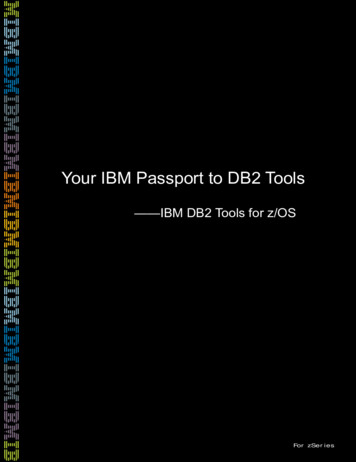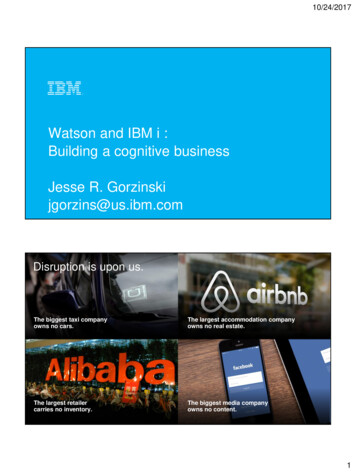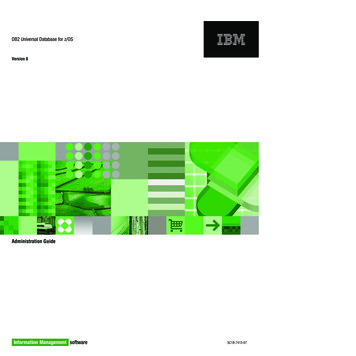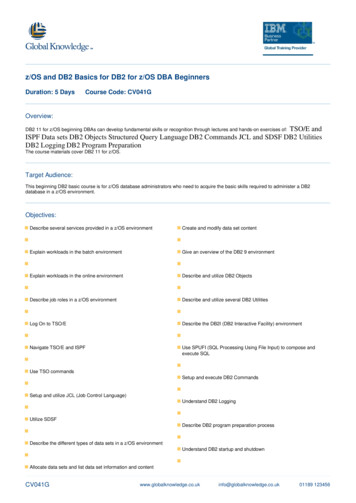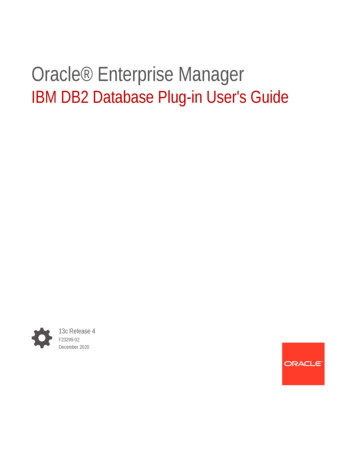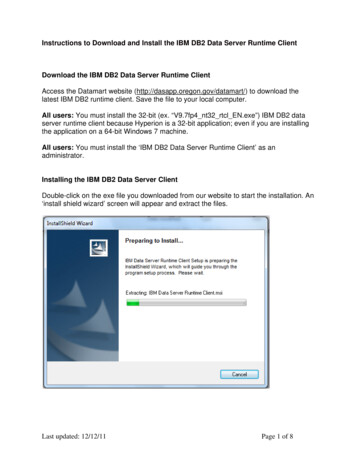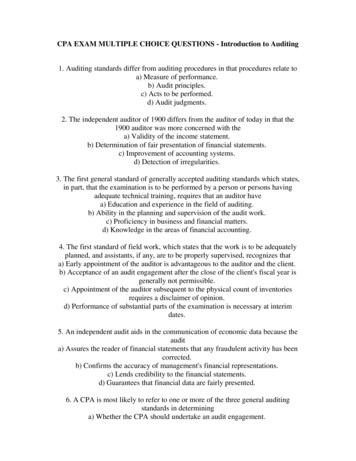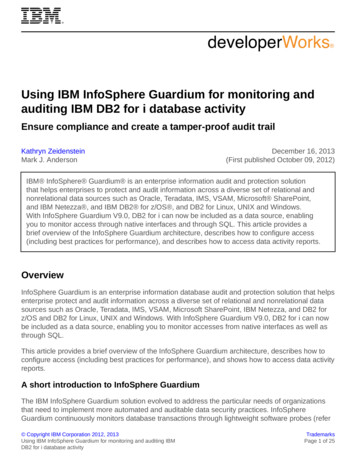
Transcription
Using IBM InfoSphere Guardium for monitoring andauditing IBM DB2 for i database activityEnsure compliance and create a tamper-proof audit trailKathryn ZeidensteinMark J. AndersonDecember 16, 2013(First published October 09, 2012)IBM InfoSphere Guardium is an enterprise information audit and protection solutionthat helps enterprises to protect and audit information across a diverse set of relational andnonrelational data sources such as Oracle, Teradata, IMS, VSAM, Microsoft SharePoint,and IBM Netezza , and IBM DB2 for z/OS , and DB2 for Linux, UNIX and Windows.With InfoSphere Guardium V9.0, DB2 for i can now be included as a data source, enablingyou to monitor access through native interfaces and through SQL. This article provides abrief overview of the InfoSphere Guardium architecture, describes how to configure access(including best practices for performance), and describes how to access data activity reports.OverviewInfoSphere Guardium is an enterprise information database audit and protection solution that helpsenterprise protect and audit information across a diverse set of relational and nonrelational datasources such as Oracle, Teradata, IMS, VSAM, Microsoft SharePoint, IBM Netezza, and DB2 forz/OS and DB2 for Linux, UNIX and Windows. With InfoSphere Guardium V9.0, DB2 for i can nowbe included as a data source, enabling you to monitor accesses from native interfaces as well asthrough SQL.This article provides a brief overview of the InfoSphere Guardium architecture, describes how toconfigure access (including best practices for performance), and shows how to access data activityreports.A short introduction to InfoSphere GuardiumThe IBM InfoSphere Guardium solution evolved to address the particular needs of organizationsthat need to implement more automated and auditable data security practices. InfoSphereGuardium continuously monitors database transactions through lightweight software probes (refer Copyright IBM Corporation 2012, 2013Using IBM InfoSphere Guardium for monitoring and auditing IBMDB2 for i database activityTrademarksPage 1 of 25
developerWorks ibm.com/developerWorks/to Figure 1) installed on the database server (or file share or Microsoft SharePoint). These probes(known as S-TAPs, for software taps) monitor all database transactions, including those of theprivileged users. The S-TAP also does not require any changes to the database or its applications.The probes forward transactions to a hardened collector on the network, where they are comparedto the previously defined policies to detect violations. The system can respond with a varietyof policy-based actions, including generating an alert and for some databases can block thetransaction in real time. (Blocking is not currently available for DB2 for i database activitymonitoring.)Figure 1. InfoSphere Guardium Database Activity MonitoringInfoSphere Guardium supports a wide variety of deployments to support very large andgeographically distributed infrastructures.As we have barely scratched the surface of what InfoSphere Guardium can do, refer to theResources section for more information about the capabilities of InfoSphere Guardium, includingdata classification to help you discover sensitive data and vulnerability assessments that help youfind soft spots in your infrastructure. Note that not all capabilities are available for all data sources.What is new?InfoSphere Guardium support for IBM i monitoring was previously available using three mainmethods: Import of audit journal entries (QSYS/QAUDJRN) and subsequent analysis and reportingWhile the audit journal support in IBM i provides a very good support of auditable events, theamount of detail in the audit entries is minimal compared to other Guardium database productsupport. For example, SQL statements and variable values are not audited in QAUDJRN.Also, as the support required an export and import, the support was not optimal as a real-timesolution. Import of database monitor entries and subsequent analysis and reportingA database monitor (STRDBMON) can be used to capture SQL statements and write themto a database table. Subsequently, the table could be imported into the Guardium collector.While this method could capture SQL statements, variables, and more; the database monitorsupport was primarily designed for performance analysis. The result was that a significantUsing IBM InfoSphere Guardium for monitoring and auditing IBMDB2 for i database activityPage 2 of 25
ibm.com/developerWorks/developerWorks amount of data that was only interesting in a performance analysis context was capturedresulting in the consumption of significant storage and processing resources. Also, as thesupport required an import, the support was not as optimal as a real-time solution. Thismethod did not provide any support for native access to database objects. Network monitoring to capture SQL accessWhile this support was able to capture SQL statements in real time that flowed over anetwork, any SQL statements than ran in programs, procedures, and functions on the IBM iserver could not be monitored. This method did not provide any support for native access tothe database objects.The new method introduced in Version 9.0 of InfoSphere Guardium provides an integrated solutionthat overcomes the limitations of the previous methods. Any SQL access whether it is initiated on a client or the IBM i server can be captured andaudited. Any native access that is captured in the audit journal can also be captured and sent to theInfoSphere Guardium collector. Both SQL access and native access are sent to the InfoSphere Guardium collector in realtime. Much more detail than that available in the audit journal including SQL statements, variablevalues, client special registers, interface information, users, jobs, Transmission ControlProtocol/Internet Protocol (TCP/IP) addresses, and ports is captured. However, unlikethe traditional database monitoring, only the data that is interesting in a security contextis captured and sent to the InfoSphere Guardium collector. This dramatically reduces thestorage and resource consumption necessary. Filtering can be specified on the IBM i server to capture only that information which is requiredby auditors. For example, it is quite simple to set up auditing of any SQL or native accessperformed by privileged users. The data that is collected for InfoSphere Guardium is never written to disk on the IBM i server,providing a level of secure logging.The new method is primarily for auditing database access. If you require auditing on a greatervariety of non-database object access, the existing IBM i auditing support of exporting andimporting the audit journal can still be used.Introducing InfoSphere Guardium database activity monitoring forDB2 for iAs we mentioned in the previous section, InfoSphere Guardium Version 9.0 database activitymonitoring has much more detailed auditing information for DB2 for i, including: Session start and end times Object names (tables or views, for example) UsersUsing IBM InfoSphere Guardium for monitoring and auditing IBMDB2 for i database activityPage 3 of 25
developerWorks ibm.com/developerWorks/SQLSTATEsJob and Job numbersSQL statements and variablesClient special register valuesTCPIP address and portInterface information, such as ODBC, ToolboxJDBC, Native JDBC, .NET, and so onThis information can be used to create activity reports, help you meet auditing requirements,and generate alerts of unauthorized activity. Figure 2 shows you some database activity fromone particular user on the system, including both a summary and more detailed version of thedata. What is important to remember is that the InfoSphere Guardium reporting infrastructureis incredibly powerful with alerting capabilities and the ability to be automated into repeatable,regularly scheduled audit processes.Figure 2. A sample SQL activity reportBy using an InfoSphere Guardium S-TAP, you can monitor both SQL and native databaseapplication programming interface (API) traffic for DB2 for i. The configuration is similar to otherdatabase S-TAPs in that the processor usage on the database server is low, and the databaseevents are sent to the InfoSphere Guardium collector for reports and alerting along with any othermonitored data sources in your environment.Two sources of data can be sent to InfoSphere Guardium (refer to Figure 3): SQL Performance Monitor (otherwise known as database monitor) data for SQL applications Audit entries from QSYS/QAUDJRN for applications using non-SQL interfacesThe DB2 for i S-TAP requires Portable Application Solutions Environment (PASE), which isautomatically started and stopped as needed when a user who has the *JOBCTL authority (orUsing IBM InfoSphere Guardium for monitoring and auditing IBMDB2 for i database activityPage 4 of 25
ibm.com/developerWorks/developerWorks QIBM DB SQLADM function usage privilege) starts and stops the DB2 for i S-TAP from theInfoSphere Guardium user interface.Figure 3. Two sources of information for database activity monitoringRequirementsThe integration requires the following prerequisites: On IBM i: for the recommended minimum releases and PTFs, see IBM i Technology Updateswiki. Refer to DB2 for IBM i 2012 Group PTF Schedule to subscribe to or review DB2 for IBM iPTF group schedule and availability. License program 5722SS1-33 Portable App Solutions Environment (PASE) for i is a freeof charge, optionally installable component of the operating system. Verify that PASE isinstalled on your IBM i server. If not, refer to the DB2 for i Information Center. IBM InfoSphere Guardium V9.0 or later appliance (configured as a collector) and theStandard Activity Monitoring for Databases software entitlement. For the DB2 server-side agent, you need to download the appropriate software tap (S-TAP)from IBM Fix Central. To ensure that you get the right S-TAP, filter on IBM i as shown here.The InfoSphere Guardium applianceThe InfoSphere Guardium Data Security and Compliance solution is available as: A fully configured software solution delivered on physical appliances provided by IBM.Using IBM InfoSphere Guardium for monitoring and auditing IBMDB2 for i database activityPage 5 of 25
developerWorks ibm.com/developerWorks/ Software images you can deploy on your own hardware either directly or as virtualappliances.Before attempting to monitor DB2 for i, ensure that you check the IBM support site for additionalpatches that might be required.This article does not provide information about the installation and configuration of the IBMInfoSphere Guardium appliance and assumes that you have at least one appliance connected tothe IBM i server.What gets collectedThe information sent from the QAUDJRN and the information sent from the database monitor arenot identical. The following table describes the information provided by each method.Table 1. Database monitor vs Audit journal data that can be collected forauditingAudit DataSQL MonitorAudit JournalJob nameYesYesJob userYesYesJob numberYesYesStart timeYesYesEnd timeYesAlways the same as the Start timeSQLSTATEYes08001 for invalid password (PW) and forgeneral purpose audit records (GR)42501 for authority failure (AF)00000 everything elseSQLCODEYes-30080 for invalid password (PW) and forgeneral purpose audit records (GR)-551 for authority failure. (AF)0 everything elseSQL statementYes – limited to 60KNo - basic journal entry description insteadSQL variablesYes - limited to 1000 bytesNoInterfaceYesAlways QAUDJRNClient application nameYes,NoClient user IDYesNoClient workstationYesNoClient accountingYesNoClient programYesNoCurrent userYesYesThread IDYesYesProgram schemaYes, if the statement is executed from aprogram or service programYes, if the statement is executed from aprogram or service programProgram nameYes, if the statement is executed from aprogram or service programYes, if the statement is executed from aprogram or service programClient IP AddressYesYesUsing IBM InfoSphere Guardium for monitoring and auditing IBMDB2 for i database activityPage 6 of 25
ibm.com/developerWorks/developerWorks Local or server port numberYesYesRDB nameYesYesNumber of rowsYes, only for INSERT, DELETE, UPDATE,MERGE, OPEN*, VALUES INTO, CREATETABLE AS, DECLARE GLOBAL TEMPORARYTABLE AS, and SET VARIABLENo*OPEN appears as SELECT in InfoSphere Guardium reports.Note that the database monitor used for audit purposes with InfoSphere Guardium does notinclude events that are not security-related. For example, activities such as FREE LOCATOR orRELEASE are not audited. EXECUTE is not audited, but the SQL statement that ran is audited.PREPARE is not audited, but any authorization errors are audited.Configure DB2 for i for QAUDJRN auditing (optional)If auditing has already been configured on the IBM i or you are only interested in SQL auditing, youcan skip this step.On the DB2 for i server, create the QSYS/QAUDJRN journal and enable auditing if not alreadydone. For more information on setting up security auditing, refer to the IBM i information center.For example, on an IBM i command line:CRTJRNRCV JRNRCV(QSYS/RCV1)CRTJRN JRN(QSYS/QAUDJRN)JRNRCV(QSYS/RCV1) DLTRCV(*YES)Next, specify the amount of auditing that you prefer to happen by setting the QAUDCTL,QAUDLVL, and QAUDLVL2 system values. For example:CHGSYSVAL SYSVAL(QAUDCTL)VALUE('*AUDLVL *OBJAUD')CHGSYSVAL SYSVAL(QAUDLVL)VALUE('*CREATE *DELETE *OBJMGT *SECURITY *SERVICE *SYSMGT *SAVRST');If you only want to audit specific users, use the CHGUSRAUD command to change auditing for auser. For example, the following command enables a variety of auditing for user MJA, who mightbe one of your privileged users. For example:CHGUSRAUD USRPRF(MJA)OBJAUD(*ALL) AUDLVL(*CREATE *DELETE *OBJMGT*SECURITY *SERVICE *SYSMGT *SAVRST *AUTFAIL)You can use the CHGOBJAUD command to change auditing for specific objects. For example, thefollowing command enables auditing for all tables, views, indexes, and aliases (*FILE objects) inthe PRODLIB schema:CHGOBJAUD OBJ(PRODLIB/*ALL) OBJTYPE(*FILE) OBJAUD(*ALL)Using IBM InfoSphere Guardium for monitoring and auditing IBMDB2 for i database activityPage 7 of 25
developerWorks ibm.com/developerWorks/Relevant QAUDJRN audit entriesThe QAUDJRN audit journal can contain a wide variety of journal entries, but only a relevantsubset is processed and sent to the InfoSphere Guardium collector.QAUDJRN journal entries that are sent for a specific object contain the object library, objectname, and object type. Only journal entries associated with the following IBM i object types will beprocessed (irrespective of whether they are associated with an SQL object or not): *FILE (a table, view, index, logical file, alias, or device file)*SQLUDT (an SQL user-defined type)*SQLPKG (an SQL package)*PGM (a procedure, function, or program)*SRVPGM (a procedure, function, global variable, or service program)*DTAARA (an SQL sequence)*USRPRF (a user profile object)QAUDJRN journal entries can contain a wide variety of audit entry types. Only the following entrytypes are processed because they have been identified to be of most use to auditors: ZR Read objectZC Change objectAD Auditing changeAF Authority failureCA Authority changeCD Command string (Note: CD is not included in the default settings offilter audit entry types)CO Create objectCP User Profile changesDO Delete objectGR General purpose audit recordOM Object moved or renamedPG Primary group changePW Invalid password or user IDOW Change ownerOR Object restoredRA Restore authority changeRO Restore owner changeRZ Restore primary group changeSV System value changeQAUDJRN journal entries do not contain the SQL statement. For journal entries that identifyan object, the following information will be concatenated and be returned in place of the SQLstatement: 30-byte-description of the operationUsing IBM InfoSphere Guardium for monitoring and auditing IBMDB2 for i database activityPage 8 of 25
ibm.com/developerWorks/developerWorks 10-byte-system-schema name 10-byte-system-object-name 8-byte-object-typeFor example:ZC - Change object MJATST T1 *FILEFor more information on the journal audit entry types, refer to Audit Journal (QAUDJRN) entrytypes in the IBM i Information Center.Install the DB2 for i S-TAP1. 1. In the PASE shell environment on the IBM i server, create a temporary directory to put theS-TAP installation script (such as /tmp). You can use a 5250 emulator software to connect tothe IBM i system remotely and enter the PASE shell by entering call qp2term.2. Use FTP to move the following S-TAP installation shell script to that temporary directory:uarditap-9.0.0 rnnnnn-aix-5.3-aix-powerpc.sh3. In the same directory, run the following command:guard-itap-9.0.0 rnnnnn-aix-5.3-aix-powerpc.sh guardium host IPwhere guardium host IP is the IP address of the InfoSphere Guardium collector. The installationprogram will install under /usr/local/guardium.After the installation is complete, InfoSphere Guardium attempts to start the processes that enableactivity monitoring and to locate the InfoSphere Guardium collector using the IP address specifiedat the installation time.To validate the successful installation and start of the audit process, log in to the InfoSphereGuardium web console as an administrator and navigate to the System View tab and check thestatus of the S-TAP, which should show green as shown in Figure 4.Figure 4. System monitor shows that configuration is successfulTroubleshootingIf the S-TAP monitor is not showing green in the status monitor, make sure you correctlyran step 3 in the installation instructions above. If you need to correct something, such asan incorrectly specified IP address, you can invoke the start istap monitor Guardium CLIcommand or create the Status report on the Guardium console to invoke that API from theUsing IBM InfoSphere Guardium for monitoring and auditing IBMDB2 for i database activityPage 9 of 25
developerWorks ibm.com/developerWorks/GUI. To create the Status report, see the instructions in the section entitled Recommended:Set up the DB2 for i Status report on the collectorThe next step, configuring the S-TAP on the InfoSphere Guardium collector is stronglyrecommended because it enables you to view S-TAP status on the IBM i server, update theconfiguration as needed, and specify filtering values.Note: The IBM InfoSphere Guardium Installation Manager (GIM) is not supported for the DB2 for iS-TAP.Recommended: Set up DB2 for i S-TAP configuration capability onthe collectorAs we mentioned in the previous section, it is strongly recommended to go ahead and set upthe configuration capability on the InfoSphere Guardium collector. You can do this by creating aconfiguration report, which enables you to invoke APIs that run on the IBM i server, which can startand stop processes and update the configuration file, QSYS2.SYSAUDIT.You must have the *JOBCTL authority or the QIBM DB SQLADM function usage privilege on IBMi to configure the environment.You must also have completed the installation steps above and the monitor process must havebeen started on the IBM i server (as validated by the STAP monitor by displaying green).In this section, you'll be doing the following steps:1. Defining DB2 for i as a recognized data source to InfoSphere Guardium and testing theconnection. For this, you will need to know the database name, port, and credentials.2. Populating the InfoSphere Guardium collector with information from the configuration fileon IBM i that was created when you installed the DB2 for i S-TAP, using the Custom TableBuilder process.3. Creating a DB2 for i configuration report. It is from this report interface that you can invokethe APIs that start and stop the monitoring process, get status information, and updateconfiguration parameters, including filtering values.Define the DB2 for i data source to InfoSphere GuardiumIn this step, you need to define your DB2 for i as a data source that the InfoSphere Guardiumcollector can recognize. You can do this by creating a custom domain and defining DB2 for i as thedata source for that domain using the Datasource Builder.To create a data source for the DB2 for i with the InfoSphere Guardium Datasource Builder:1. Click Tools Datasource Definitions then select Custom Domain from the ApplicationSelection box. Click Next.Using IBM InfoSphere Guardium for monitoring and auditing IBMDB2 for i database activityPage 10 of 25
ibm.com/developerWorks/developerWorks 2. In the Datasource Finder, click New, which brings up the Datasource Builder. Select DB2 fori as the database type and then add the appropriate information for the port, host, servicename (which is the database name), and credentials. Also, enter a meaningful name for thisdefinition.3. Click Apply and then click Test Connection to ensure all is configured correctly.Using IBM InfoSphere Guardium for monitoring and auditing IBMDB2 for i database activityPage 11 of 25
developerWorks ibm.com/developerWorks/Upload the DB2 for i configuration settings to the InfoSphere Guardiumcollector using a custom table builderIn this step, you use the InfoSphere Guardium interface to import the configuration informationfrom the IBM i system. You do this by performing the following steps.1. Invoke the report building interface.2. Create a custom table on the local InfoSphere Guardium to hold the configuration data fromthe DB2 for i data source.3. Import the configuration data from DB2 for i to that custom table.Here are the detailed steps:1. Click Tools Report Building. (Hint: You might need to scroll down to find the Report Buildingoption on the left.)2. Click Custom Table Builder, and select DB2 for i S-TAP Configuration and then clickUpload Data.3.Click Add Datasource .4. On the Datasource Finder, locate your DB2 for i data source on the list and then click Add.Using IBM InfoSphere Guardium for monitoring and auditing IBMDB2 for i database activityPage 12 of 25
ibm.com/developerWorks/developerWorks 5. On the Import Data screen, ensure the DB2 for i data source appears. Click Apply and thenclick Run Once Now. You should see a message that the operation ended successfully.Creating the configuration report to invoke InfoSphere Guardium APIsThis section explains the following major tasks:Using IBM InfoSphere Guardium for monitoring and auditing IBMDB2 for i database activityPage 13 of 25
developerWorks ibm.com/developerWorks/ An optional task to customize the InfoSphere Guardium interface to create a space (that is, apane) where you can put the new configuration report for DB2 for i. We will use the name MyNew Reports for this pane. (If you are logged in as a user rather than an administrator, the MyNew Reports pane will already exist.) A task to search for and add the DB2 for i S-TAP configuration report to the pane. After thatconfiguration report exists, you can invoke the APIs to change the configurations for DB2 for i.For more information about creating reports, refer to the InfoSphere Guardium Information Centertopic on How to build a report and customize parameters.To create a report pane (only required if one does not exist):1. To create the My New Reports pane, from the upper right corner of the Guardium UI, clickCustomize then click the Add Pane button, as shown below.2. Give the pane a new name, My New Reports (spelled exactly). Click Apply and then Save.3. My New Reports will appear in the Customize Pane. Click on the icon to the left of that item.On the Layout pulldown, choose Menu Pane, and then Save. Your new pane will appear as atab.Create the configuration report and add to the report pane:1. Now you are ready to create the configuration report to add to the new report pane. To dothis, click on Report Builder in the left navigation pane. In the right pane, from the Query list,select DB2 for i S-TAP configuration, and then click Search.Using IBM InfoSphere Guardium for monitoring and auditing IBMDB2 for i database activityPage 14 of 25
ibm.com/developerWorks/developerWorks 2. Select DB2 for i S-TAP configuration and then click the Add to My New Reports button, asshown below (or add the report to an existing pane by clicking Add to Pane )3. Click on the My New Reports tab which now will be displaying the IBM i report row. Doubleclick a row in the report and then click Invoke.4. Now you can see the InfoSphere Guardium APIs. Click update istap config.The section Overview of DB2 for i S-TAP APIs includes more information about the configurationAPI parameters available from that report and a brief overview of the other APIs.Using IBM InfoSphere Guardium for monitoring and auditing IBMDB2 for i database activityPage 15 of 25
developerWorks ibm.com/developerWorks/Recommended: Set up the DB2 for i status report on the collectorAnother very useful report you need to have handy on your console is the status report. Thesteps to add this report are almost exactly the same as those described in the previous section,Recommended: Set up DB2 for i S-TAP configuration capability on the Collector. In summary:1. As an administrator, navigate to Tools Report Building Customer Table Builder.2. Select DB2 for i Status, and then click Upload Data.3. Add the Datasource, then on the Import Data screen, click Apply and then Run Once Now.4. Navigate to the Report Builder, search on the report title of DB2 for i Status and then Add toMy New Reports.Here is an example of the Status report:Figure 5.You can double click on the report to start and stop the monitor on the server as well as refresh thestatus.Figure 6.Overview of DB2 for i S-TAP APIsThere are several ways to invoke InfoSphere Guardium APIs. In this article, we just show how toinvoke them from the DB2 for i S-TAP Configuration and Status Reports. As you learned in theprevious section, you can double click in the report to invoke APIs Selecting an API brings up theallowable parameters for that particular API. In this case, as shown in Figure 7, you can use theupdate istap config API to send information, such as the IP address of the InfoSphere Guardiumcollector, and to start or restart the auditing processes on the i system. (If the value is "unchange"then that parameter will not be updated.) You'll learn more about the value of the filtering options inthe section Filtering audit data on the IBM i server.Using IBM InfoSphere Guardium for monitoring and auditing IBMDB2 for i database activityPage 16 of 25
ibm.com/developerWorks/developerWorks Figure 7. Options to update the IBM i S-TAP configuration usingWhen the value for start monitor is set to 1 (default), the auditing process will start (or restart) onthe i server after the configuration table is updated. When the auditing process is started, storedprocedures on DB2 for i are invoked that will: Create the message queue that will be used to send entries to the InfoSphere Guardiumcollector and starts a global database monitor using a view with an INSTEAD OF trigger(which sends the entries to the message queue) Start PASE and S-TAP. Receive journal entries from QAUDJRN and add them to the message queue.Invocable S-TAP APIs for IBM iTo provide for scripting and automation, the S-TAP APIs can be invoked from the commandline interface (CLI) in InfoSphere Guardium.Here is an overview of the APIs for IBM i monitoring: start istap monitor will start the audit process on IBM i. stop istap monitor will stop the audit processes on IBM i. get istap status can be used to check whether the audit server is running andit includes other information (such as the number of messages on the queue, thesize of the message queue, and so on) that can be useful for troubleshooting andperformance tuning. get istap config can be used to view configuration parameters, including the currentfiltering options. update istap config can be used to update the configuration settings on IBM i.When the S-TAP connects to the collector, a row similar to the one shown in Figure 4 appears inthe System View tab.Using IBM InfoSphere Guardium for monitoring and auditing IBMDB2 for i database activityPage 17 of 25
developerWorks ibm.com/developerWorks/View monitoring reportsAfter the system is configured and auditing is underway, you can start taking advantage of the realpower of InfoSphere Guardium to run reports, set alerts, and much more. InfoSphere Guardiumhas a rich reporting interface, which is beyond the scope of this article.When creating reports, depending on whether you have logged in as an administrator or as a user,the navigation paths might be different. Therefore, make sure to read the How to build a report andcustomize parameters and How to create custom reports from stored data topics in the InfoSphereGuardium Information Center, or by clicking on the question mark icon an the upper-right corner ofthe user interface to access the help book.To use reports that show the database activity details, you need to be logged in as a user and thatis what this section of the article assumes. Note that the InfoSphere Guardium user interface ishighly customizable, so the screen captures and the navigation paths shown here might not workexactly as shown at your site.This procedure assumes that the S-TAP configuration is successful and that the database activityis occurring on DB2 for i.1. Click the View tab. (Optional: Rename this tab toStandard Reports by clicking the pencil iconon the tab and then clicking Edit Properties.2. You should see some reports as shown here.3. Double click on the graph, which brings up a tabular view that you can use to start drilldownby double clicking on subsequent report tables.Using IBM InfoSphere Guardium for monitoring and auditing IBMDB2 for i database activityPage 18 of 25
ibm.com/developerWorks/developerWorks 4. You can drill down through the data such asa. Sessions by server IP, then double click on a rowb. Sessions by user, then dou
Introducing InfoSphere Guardium database activity monitoring for DB2 for i As we mentioned in the previous section, InfoSphere Guardium Version 9.0 database activity monitoring has much more detailed auditing information for DB2 for i, including: Session start and end times Object names (tables or views, for example) Users
